1993 PONTIAC GRAND-AM belt
[x] Cancel search: beltPage 41 of 306

Seats & Safety 6elts
Sahty Belt Extender
If the vehicle’s safety belt will fasten
around you, you should use it.
The automatic lap-shoulder belt has
plenty of extra length built in,
so it will
fasten around almost all people.
But if a safety belt isn’t long enough to
ksten, your dealer will order you an
extender. It’s free. When you go in to
order it, take the heaviest coat you will
wear,
so the extender will be long
enough for
you. The extender will be
just for you, and just for the seat
in your
vehicle that you choose. Don’t let
someone else use it, and use it only for
the seat it is made to fit. To wear it, just
attach it to the regular safety belt.
Checking Your Restraint Systems
Now and then, make sure all your belts,
buckles, latch plates, retractors, anchorages and reminder systems are
working properly.
Look for any loose
parts or damage. If you
see anything that
might keep a restraint system
from
doing its job, have it repaired.
Replacing Satiety Belts After a
Crash
If you’ve had a crash, do you need new
belts?
After a very minor collision, nothing may be necessary.
But if the belts were
stretched, as they would be if worn
during a more severe crash, then you
need new belts.
If belts are cut or damaged, replace
them. Collision damage
also may mean
you will have to have safety belt parts, like the retractor, replaced or anchorage
locations repaired-even if the belt
wasn’t being used at
the time of the
collision.
888 40
ProCarManuals.com
Page 42 of 306
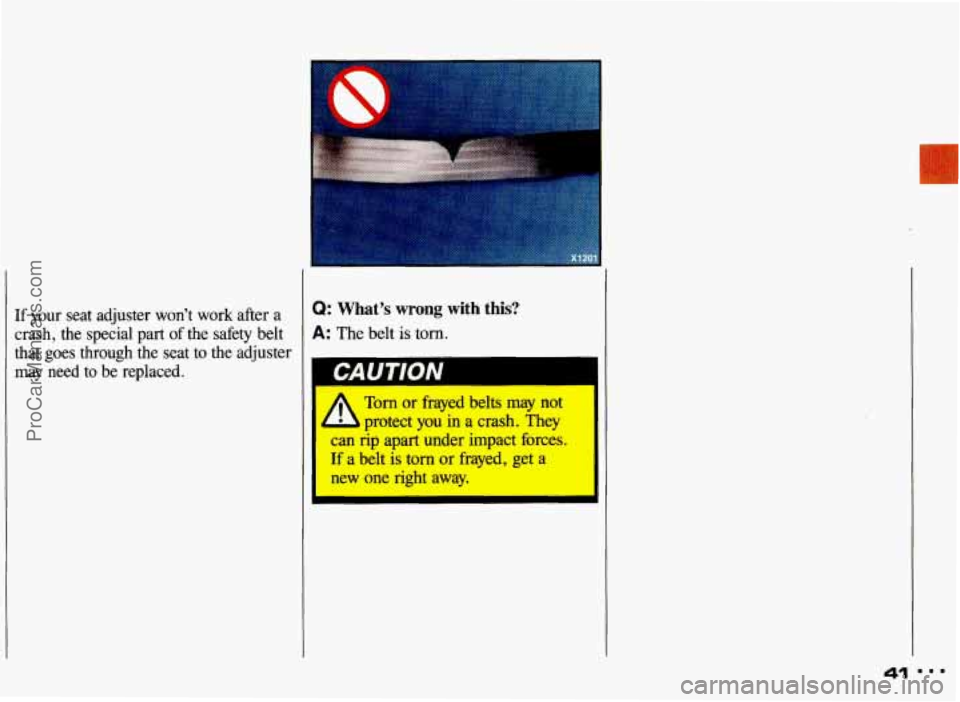
I-
If your seat adjuster won’t work after a Q: What’s wrong with this?
crash, the special part of the safety belt A: The belt is torn.
that goes through the seat to the adjuster
may need
to be replaced. I bAU I IUlV
Torn or frayed belts may not
L protect you in a crash. They
can rip apart under impact forces.
If a belt
is torn or frayed, get a I I new one right away. 1
ProCarManuals.com
Page 46 of 306
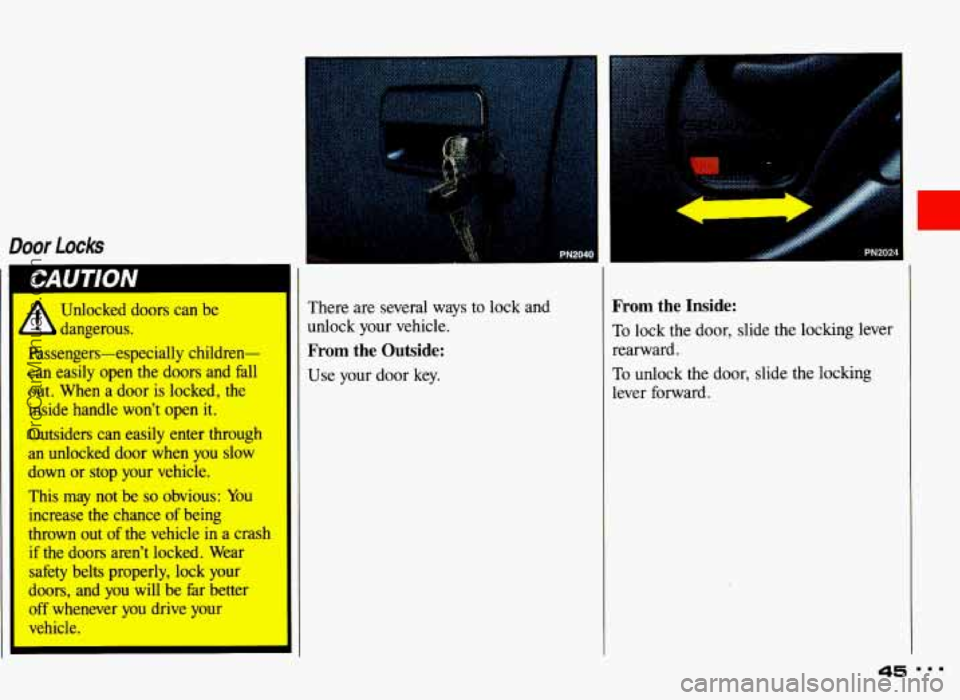
Door locks I
1 CAUTION
* Unlocked doors can be
- dangerous.
Passengers-especially children-
can easily open the doors and fall
out. When a door is locked, the
inside handle won’t open
it.
Outsiders can easily enter through
an unlocked door when you slow
down or stop your vehicle.
This may not be
so obvious: You
increase the chance of being
thrown out of the vehicle in a crash
if the doors aren’t locked. Wear
safety belts properly, lock your
doors, and you will be far better
off whenever you drive your
vehicle.
..
There are several ways to lock and
unlock
your vehicle.
From the Outside:
Use your door key.
From the Inside:
To lock the door, slide the locking lever
rearward.
To unlock the door, slide the locking
lever forward.
45 =.=
ProCarManuals.com
Page 96 of 306
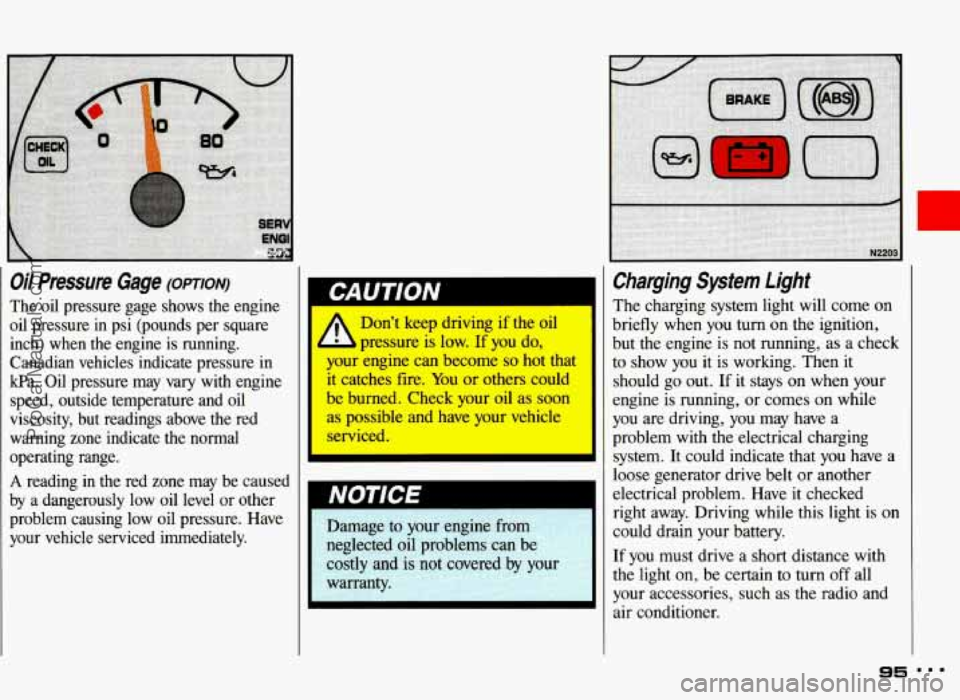
Oil Pressure Gage (omrorv)
The oil pressure gage shows the engine
oil pressure in psi (pounds per square
inch) when the engine is running.
Canadian vehicles indicate pressure in
kPa. Oil pressure may vary with engine
speed, outside temperature and
oil
viscosity, but readings above the red warning zone indicate the normal
operating range.
A reading in the red zone may be caused
by a dangerously low oil level
or other
problem causing low oil pressure. Have
your vehicle serviced immediately.
A
Don’t keep driving if the oil
pressure is low.
If you do,
your engine can become
so hot that
it catches fire. You or others could
be burned. Check your oil as soon
as possible and have your vehicle
serviced.
Charging System Light
The charging system light will come on
briefly when you
turn on the ignition,
but the engine is not running, as a check
to show you it is working. Then it
should go out.
If it stays on when your
engine is running, or comes on while
you are driving, you may have a
problem with the electrical charging
system. It could indicate that
you have a
loose generator drive belt or another
electrical problem. Have it checked
right away. Driving while this light is on
could drain your battery.
If you must drive a short distance with
the light on, be certain to
turn off all
your accessories, such as the radio and
air conditioner.
95
ProCarManuals.com
Page 127 of 306
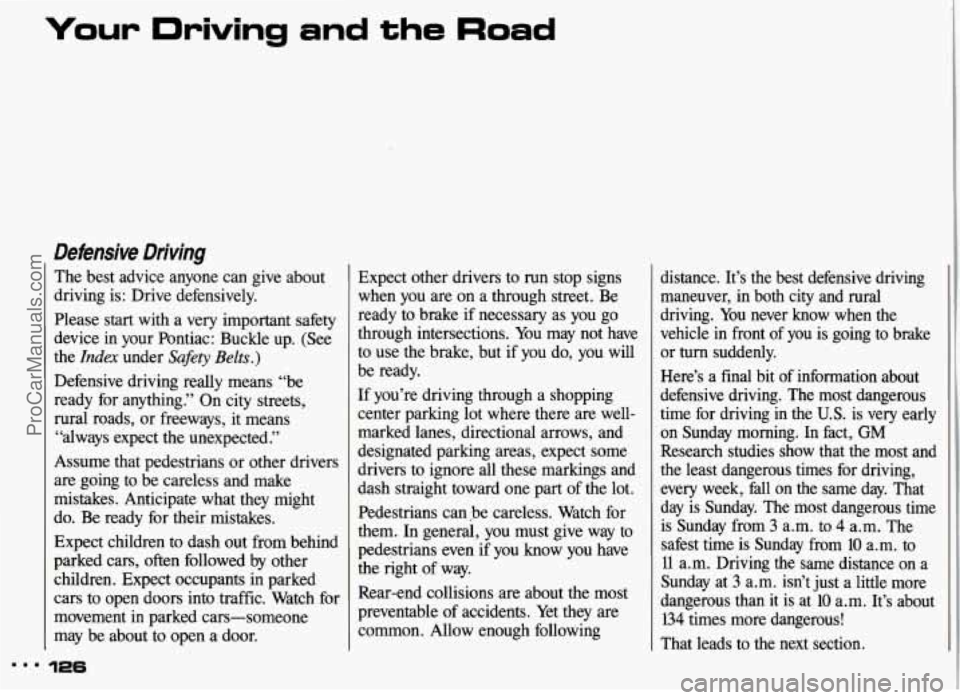
Defensive Driving
The best advice anyone can give about
driving is: Drive defensively.
Please start with a very important safety
device in your Pontiac: Buckle up. (See
the
Index under Safety Belts.)
Defensive driving really means “be
ready for anything.” On city streets,
rural roads, or freeways, it means
“always expect the unexpected
.”
Assume that pedestrians or other drivers
are going to be careless and make
mistakes. Anticipate what they might
do. Be ready for their mistakes.
Expect children to dash out from behind
parked cars, often followed
by other
children. Expect occupants in parked
cars to open doors into traffic. Watch for
movement in parked cars-someone
may be about to open a door.
126
Expect other drivers to run stop signs
when you are on a through street. Be
ready to brake if necessary as you go
through intersections. You may not have
to use the brake, but if you do, you will
be ready.
If you’re driving through a shopping
center parking lot where there are well-
marked lanes, directional arrows, and
designated parking areas, expect some
drivers to ignore all these markings and
dash straight toward one part of the lot.
Pedestrians canbe careless. Watch for
them.
In general, you must give way to
pedestrians even if you know you have
the right of way.
Rear-end collisions are about the most
preventable of accidents. Yet they are
common. Allow enough following distance. It’s the best defensive driving
maneuver, in both city and rural
driving. You never know when the
vehicle in front
of you is going to brake
or
turn suddenly.
Here’s a final bit of information about
defensive driving. The most dangerous
time for driving in the
U.S. is very early
on Sunday morning. In fact, GM
Research studies show that the most and
the least dangerous times for driving,
every week, fall on the same day. That
day is Sunday. The most dangerous time is Sunday from
3 a.m. to 4 a.m. The
safest time is Sunday from
10 a.m. to
11 a.m. Driving the same distance on a
Sunday at
3 a.m. isn’t just a little more
dangerous than it is at
10 a.m. It’s about
134 times more dangerous!
That leads to the next section.
ProCarManuals.com
Page 138 of 306
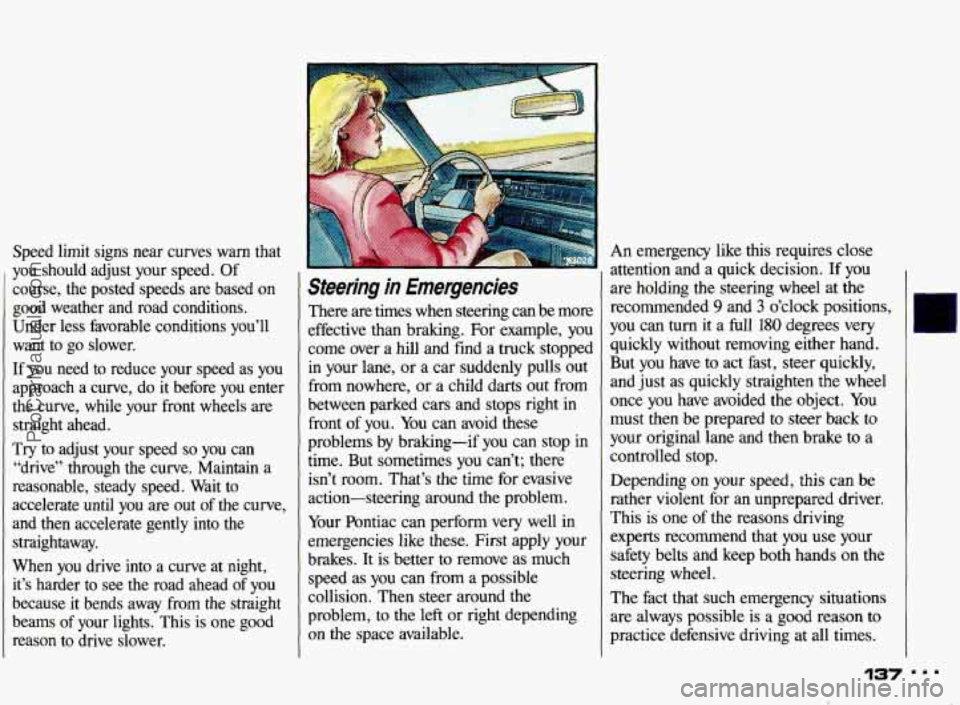
Speed limit signs near curves warn that
you should adjust your speed. Of
course, the posted speeds are based
on
good weather and road conditions.
Under less favorable conditions you’ll
want to go slower.
If you need to reduce your speed as you
approach a curve, do it before you enter
the curve, while your front wheels are
straight ahead.
Try to adjust your speed
so you can
“drive” through the curve. Maintain a
reasonable, steady speed. Wait to
accelerate until
you are out of the curve,
and then accelerate gently into the
straightaway.
When
you drive into a curve at night,
it’s harder to see the road ahead of you
because it bends away from the straight
beams of your lights. This is one good
reason to drive slower.
Steering in Emergencies
There are times when steering can be more
effective than braking. For example, you
come over a hill and find a truck stopped
in your lane, or a car suddenly pulls out
from nowhere, or a child darts out from
between parked cars and stops right in
front of you.
You can avoid these
problems by braking-if
you can stop in
time. But sometimes you can’t; there
isn’t
room. That’s the time for evasive
action-steering around the problem.
Your Pontiac can perform very well in
emergencies like these. First apply your
brakes. It is better to remove as much
speed as you can from a possible
collision. Then steer around the
problem, to the left or right depending
on the space available. An emergency like this requires
close
attention and
a quick decision. If you
are holding the steering wheel at the
recommended
9 and 3 o’clock positions,
you can turn it a
full 180 degrees very
quickly without removing either hand.
But
you have to act fast, steer quickly,
and just as quickly straighten the wheel
once
you have avoided the object. You
must then be prepared to steer back to
your original lane and then brake to a
controlled stop.
Depending on your speed, this can
be
rather violent for an unprepared driver.
This is one of the reasons driving
experts recommend that
you use your
safety belts and keep both hands on the
steering wheel.
The fact that such emergency situations
are always possible is a good reason to
practice defensive driving at all times.
ProCarManuals.com
Page 167 of 306

Your Driving and the Road
Driving with a mailer (CONT.)
4. Reapply the regular brakes. Then
apply your parking brake, and then shift to
P (Park), or R (Reverse) for a
manual transaxle.
5. Release the regular brakes.
When You Are Ready to Leave After
Parking on a
Hill
1. Apply your regular brakes and hold
the pedal down while you:
Start your engine;
Shift into a gear; and
Release the parking brake.
2. Let up on the brake pedal.
3. Drive slowly until the trailer is clear
4. Stop and have someone pick up and
of the chocks.
store the chocks.
Maintenance When Tmiler Towing
Your vehicle will need service more
often when you’re pulling a trailer. See
the Maintenance Schedule for more on
this. Things that are especially important in trailer operation are
automatic transaxle fluid (don’t overfiil),
engine oil, belts, cooling system, and
brake adjustment. Each
of these is
covered
in this manual, and the Ida
will help you find them quickly. If
you’re trailering, it’s a good idea to
review these sections before you
start
your trip.
Check periodically to see that all hitch
nuts and bolts are tight.
m.. 166
ProCarManuals.com
Page 235 of 306

Service & Appearance Care
Tire Inspection and Rotation
(CONT)
1 Rust or dirt on a wheel, or on
- b the. parts to which it is
htened, ean fnake wheel nuts I
become loose after a time, The
wheel could come off and cause an I accident. When you change a
wheel, remove any rust or dirt
from plks where the wheel
When lt’s Time for New Tires
One way to tell when it’s time for new
tires is to check the treadwear
indicators, which will appear when your
tires have only
2/32 inch (1.6 mm) or
less of tread remaining.
You need a new tire if:
You can see the indicators at three
You can see cord or fabric showing
The tread or sidewall is cracked. cut.
places around the tire.
through the tire’s rubber.
attaches to the vehicle. ~n an 7 -
emergency, you can use a cloth or I I or snagged deep enough to show cord
a ppr towel ta do this; but be or fabric.
sure t.a use a scraper or wire brush The tire has a bump, bulge or split.
later, if you need to, to get all the The tire has a puncture, cut, or other
rust or dirt off, (See the Index damage that can’t be repaired well
undkr hgiing a 2?i?af Ere.) because of the size or location of the
I damage.
... 234
Buying New Tires
To find out what kind and size of tires
you need, look at the Tire-Loading
Information label.
The tires installed on your vehicle when
it was new had a Tire Performance
Criteria Specification (TPC Spec)
number on each tire’s sidewall. When
you get new tires, get ones with that
same TPC Spec number. That way, your
vehicle will continue to have tires that
are designed to give proper endurance,
handling, speed rating, traction, ride and other things during normal service
on your vehicle.
If your tires have an all-
season tread design, the TPC number
will be followed by a
“MS” (for mud
and snow).
If you ever replace your tires with those
not having a TPC Spec number, make
sure they are the same size, load range,
speed rating and construction type (bias,
bias-belted
or radial) as your original
I tires.
ProCarManuals.com